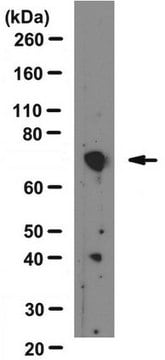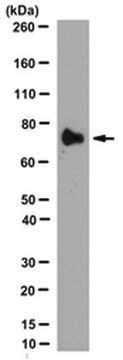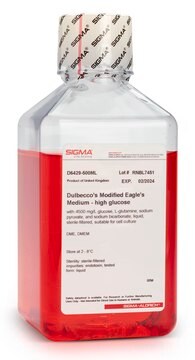AV33090
Anti-MMP9 antibody produced in rabbit
IgG fraction of antiserum
Sign Into View Organizational & Contract Pricing
Select a Size
All Photos(4)
Select a Size
Change View
About This Item
UNSPSC Code:
12352203
NACRES:
NA.41
Recommended Products
biological source
rabbit
Quality Level
conjugate
unconjugated
antibody form
IgG fraction of antiserum
antibody product type
primary antibodies
clone
polyclonal
form
buffered aqueous solution
mol wt
78 kDa
species reactivity
human, dog, mouse, guinea pig, horse, bovine, sheep, rat, rabbit
concentration
0.5 mg - 1 mg/mL
General description
Matrix metalloproteinase-9/gelatinase B (MMP-9), a member of the matrix metalloproteinase (MMP) family, is involved in the breakdown of extracellular matrix giving it a role in normal physiological processes such as embryonic development, tissue remodeling, wound repair, vascularization and inflammatory response. MMP-9 is involved in synaptic plasticity. MMP-9 functions in modulating hippocampal synaptic physiology and plasticity.
Immunogen
Synthetic peptide directed towards the N terminal region of human MMP9
Application
Applications in which this antibody has been used successfully, and the associated peer-reviewed papers, are given below.
Western Blotting (1 paper)
Western Blotting (1 paper)
Rabbit polyclonal anti-MMP9 antibody is used to tag matrix metalloproteinase-9/gelatinase B for detection and quantitation by immunocytochemical and immunohistochemical (IHC) techniques. It is used as a probe to determine the presence and roles of matrix metalloproteinase-9/gelatinase B in processe such as synaptic plasticity.
Biochem/physiol Actions
Proteins of the matrix metalloproteinase (MMP) family are involved in the breakdown of extracellular matrix in normal physiological processes, such as embryonic development, reproduction, and tissue remodeling, as well as in disease processes, such as arthritis and metastasis. Most MMP′s are secreted as inactive proproteins which are activated when cleaved by extracellular proteinases. The enzyme encoded by MMP9 degrades type IV and V collagens. Studies in rhesus monkeys suggest that the enzyme is involved in IL-8-induced mobilization of hematopoietic progenitor cells from bone marrow, and murine studies suggest a role in tumor-associated tissue remodeling.
Sequence
Synthetic peptide located within the following region: VAEHGDGYPFDGKDGLLAHAFPPGPGIQGDAHFDDDELWSLGKGVVVPTR
Physical form
Purified antibody supplied in 1x PBS buffer with 0.09% (w/v) sodium azide and 2% sucrose.
Disclaimer
Unless otherwise stated in our catalog or other company documentation accompanying the product(s), our products are intended for research use only and are not to be used for any other purpose, which includes but is not limited to, unauthorized commercial uses, in vitro diagnostic uses, ex vivo or in vivo therapeutic uses or any type of consumption or application to humans or animals.
Not finding the right product?
Try our Product Selector Tool.
Storage Class Code
10 - Combustible liquids
WGK
WGK 3
Flash Point(F)
Not applicable
Flash Point(C)
Not applicable
Choose from one of the most recent versions:
Certificates of Analysis (COA)
Lot/Batch Number
Don't see the Right Version?
If you require a particular version, you can look up a specific certificate by the Lot or Batch number.
Already Own This Product?
Find documentation for the products that you have recently purchased in the Document Library.
Prashant Nighot et al.
American journal of physiology. Gastrointestinal and liver physiology, 309(12), G988-G997 (2015-10-31)
Recent studies have implicated a pathogenic role for matrix metalloproteinases 9 (MMP-9) in inflammatory bowel disease. Although loss of epithelial barrier function has been shown to be a key pathogenic factor for the development of intestinal inflammation, the role of
K Nagaoka et al.
Oncogene, 35(22), 2893-2901 (2015-09-29)
In mouse mammary epithelial cells, cytoplasmic polyadenylation element binding protein 1 (CPEB1) mediates the apical localization of ZO-1 mRNA, which encodes a critical tight junction component. In mice lacking CPEB1 and in cultured cells from which CPEB has been depleted
Mirel-Adrian Popa et al.
Journal of molecular endocrinology, 60(1), 1-15 (2017-12-17)
The use of mesenchymal stem cells (MSC) as a therapeutic tool in cardiovascular diseases is promising. Since androgens exert some beneficial actions on the cardiovascular system, we tested our hypothesis that this hormone could promote MSC-mediated repair processes, also. Cultured
Dong Zhao et al.
Molecular medicine reports, 14(6), 4983-4990 (2016-11-15)
Tanshinone II A (TSIIA) is a diterpene quinone extracted from the roots of Salvia miltiorrhiza with anti-inflammatory and anti‑oxidant properties that is used to treat atherosclerosis. In the current study, morphological analyses were conducted to evaluate the effects of TSIIA on
Fengwu Li et al.
Cell transplantation, 28(2), 145-156 (2018-12-21)
Ischemic stroke destroys blood-brain barrier (BBB) integrity. There are currently no effective treatments available in the clinical setting. Post-ischemia treatment with phenothiazine drugs [combined chlorpromazine and promethazine (C+P)] has been shown to be neuroprotective in stroke. The present study determined
Our team of scientists has experience in all areas of research including Life Science, Material Science, Chemical Synthesis, Chromatography, Analytical and many others.
Contact Technical Service








